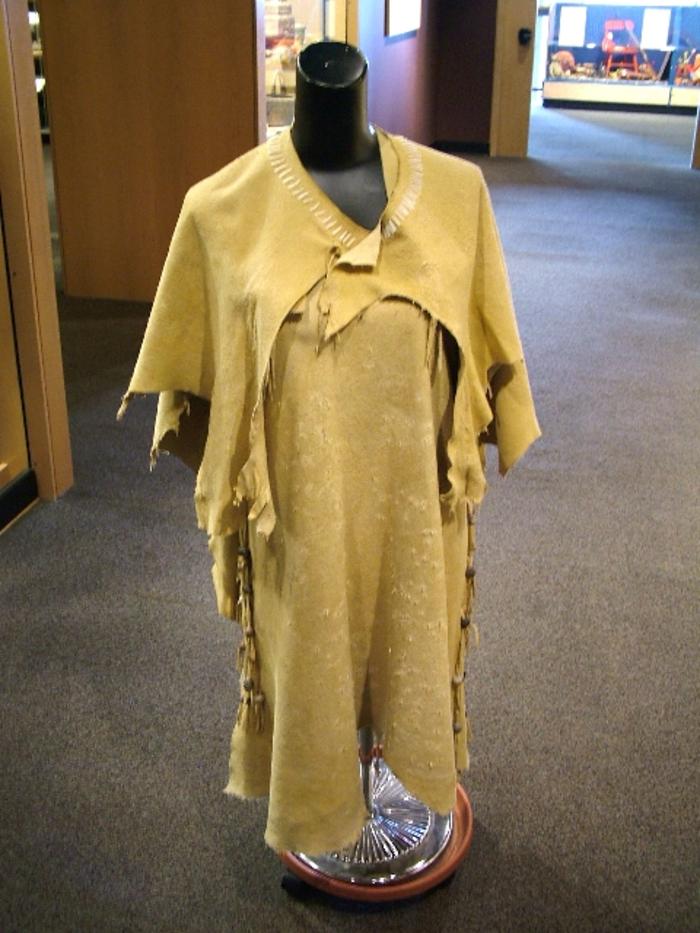Comments and Tags
Be the first to comment on this item!
Buckskin Dress
Identifier:
E1999.11.1Description:
Native American style 'strap' dress, with one deerskin used for the yoke and one each for front and back of dress. Collar lined with dentalia shells. Side seams attached with buckskin thongs adorned with one modern clay bead at each end of thong, each thong being then split into three fringes each. Beads glitter with metallic inclusions. Intended as a reproduction of pre-contact Great Lakes Native American clothing. Any references or other documentation used in design remain obscure. Curatorial recommendation to accept is based on prior agreement for trade, however museum staff did not provide maker with any guidance. Attempts to validate this piece with known examples or historic records is inconclusive. Strap dresses of this basic design were made of cloth during the trade period, but dentalia shells are not represented in the pre-contact archaeological record. The bead maker's qualifications and experience in reproducing pre-contact bead examples is unknown. Examples of skin clothing from this area are very rare.;Can be used to suggest what pre-contact Native American clothing and decorations may have looked like.;Symbol on front of dress: box with crossed corners (log cabin style) and dots inside each corner. Flanked with short zig-zag lines resembling lightning. Mae's 'logo' under left sleeve: letter 'M' with tails flared outward at bottom. Tails extend beyond circle drawn around the 'M'. Circle is not perfect, ends cross at top of symbol.;Created for use in educational programs. Traded for Native American female adult mannikin from People of the Grand exhibit diorama.;Made for use in educational programs;M. RING |Date:
1998Materials:
Deerskin Buckskin Clay Beads Dentalia ShellsDimensions:
47" h 44" wCurrent Location Status:
On ExhibitCollection Tier:
Tier 3Source:
Gift Of Ring, MaeExhibit/Program:
Grand Fish, Grand River (after 2016)Grand River, Grand Fish explores how the Great Lakes region’s largest and oldest fish, the Lake Sturgeon, once found in great abundance, is now a threatened species in our watersheds. The exhibit takes visitors through the connections to Native Americans, fishing history in the region and current science. Using artifacts from the GRPM Collections, along with the two live sturgeon, it will tie together the cultural, historical and scientific connections and explore rehabilitation efforts for this species in the Grand River and throughout the Great Lakes region.
Related Entities:
Mae Ring (creator)Mae Ring (1935-2005) was born and raised in Michigan. Although not Native American, she is generally credited with the rediscovery of the traditional Native American art of fingerweaving. Ring was the former wife of Isaac (Ike) Peters and passed her intricate fingerweaving skills on to their daughter, Renee Dillard. Many of Ring's handmade pieces are on display in the GRPM. (Source: Canku Ota - September 1, 2010 - Local Tribal Member To Receive 2010 Michigan Heritage Award) Mae Ring (donor)
Mae Ring (1935-2005) was born and raised in Michigan. Although not Native American, she is generally credited with the rediscovery of the traditional Native American art of fingerweaving. Ring was the former wife of Isaac (Ike) Peters and passed her intricate fingerweaving skills on to their daughter, Renee Dillard. Many of Ring's handmade pieces are on display in the GRPM. (Source: Canku Ota - September 1, 2010 - Local Tribal Member To Receive 2010 Michigan Heritage Award)
